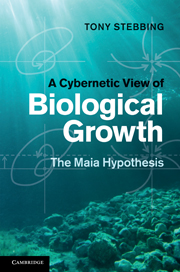Book contents
- Frontmatter
- Contents
- Foreword by Ernest Naylor
- Preface: ‘A fragment of a possible world’
- Acknowledgements
- 1 Introduction
- 2 Growth unlimited: blooms, swarms and plagues
- 3 Self-regulating systems: from machines to humans
- 4 The wealth of homeodynamic responses
- 5 A cybernetic approach to growth analysis
- 6 A control mechanism for Maia
- 7 The three levels of adaptation
- 8 Population growth and its control
- 9 Hierarchy: a controlled harmony
- 10 History of hormesis and links to homeopathy
- 11 Maian mechanisms for hormesis and catch-up growth
- 12 Cellular growth control and cancer
- 13 Human overpopulation
- 14 Our finite Earth
- 15 The Maia hypothesis and anagenesis
- Glossary
- Further reading
- References
- Index
6 - A control mechanism for Maia
Published online by Cambridge University Press: 10 January 2011
- Frontmatter
- Contents
- Foreword by Ernest Naylor
- Preface: ‘A fragment of a possible world’
- Acknowledgements
- 1 Introduction
- 2 Growth unlimited: blooms, swarms and plagues
- 3 Self-regulating systems: from machines to humans
- 4 The wealth of homeodynamic responses
- 5 A cybernetic approach to growth analysis
- 6 A control mechanism for Maia
- 7 The three levels of adaptation
- 8 Population growth and its control
- 9 Hierarchy: a controlled harmony
- 10 History of hormesis and links to homeopathy
- 11 Maian mechanisms for hormesis and catch-up growth
- 12 Cellular growth control and cancer
- 13 Human overpopulation
- 14 Our finite Earth
- 15 The Maia hypothesis and anagenesis
- Glossary
- Further reading
- References
- Index
Summary
The study of growth consists largely in the study of the control and limitation of growth.
J.Z. YoungTo regulate something always requires two opposing factors.
Albert Szent-GyörgyiWhat is true for E. coli is also true for the elephant.
Jacques MonodDYNAMIC EQUILIBRIA IN INERT SYSTEMS
The principle of homeostasis became a central and abiding theme in the physiology of animals. Once adopted, it was never abandoned, because for all life homeodynamic systems have great survival value, conferring control over external perturbation that would otherwise disrupt internal processes. The result was a balance of opposing forces of perturbation and counter-response that characterises homeodynamic systems. But how did such systems originate?
Maia emerges as a mechanism that creates stability in growth rate, but what within the organism is the particular mechanism that accounts for the observed behaviour? What are the specific elements which create the kind of output that we have come to recognise as typical of growth control mechanisms? Before looking in more detail at living control mechanisms, we should be aware that some kinds of regulatory behaviour can also be found in non-living physical and chemical systems. As they preceded whatever biological evolution added later, such systems may have provided the precursors of homeostasis.
About a hundred sentences of what the Greek philosopher Heracleitus wrote still survive; his one book was lost, yet his ideas on cosmology continue to have an influence. He derided men for failing to understand the logos, meaning the reason, or the order that pervades in universal processes.
- Type
- Chapter
- Information
- A Cybernetic View of Biological GrowthThe Maia Hypothesis, pp. 116 - 137Publisher: Cambridge University PressPrint publication year: 2010



